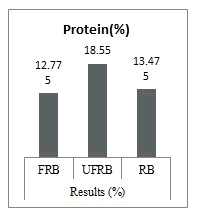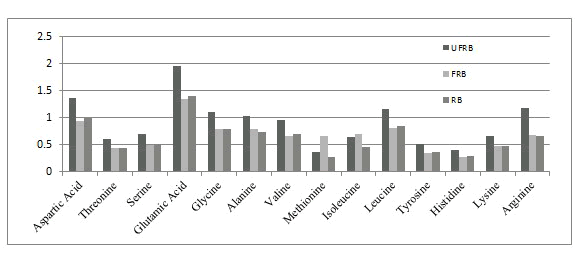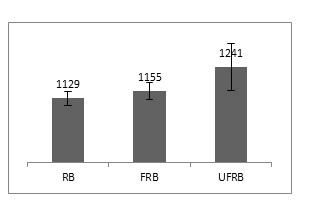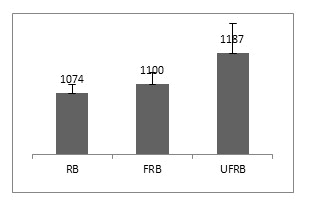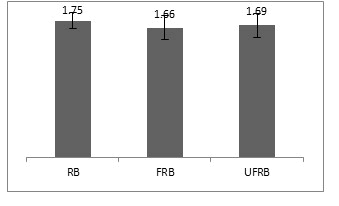Research Article, J Vet Med Sci Vol: 11 Issue: 5
Effect of Feeding Fermented Rice Bran by Rumen Liquor on the Growth Performance of Broiler
Muhammad Ashiqul Alam1*, Muhammad Shahidur Rahman Khan2, Khan Muhammad Shaiful Islam3, U Dickhofer4 and M A Grashorn5
1Department of Microbiology and Public Health, Khulna Agricultural University, Khulna, Bangladesh
2Department of Microbiology and Hygiene, Bangladesh Agricultural University(BAU), Khulna, Bangladesh
3Department of Animal Nutrition, Bangladesh Agricultural University (BAU), Mymensingh, Bangladesh
4Department of Agriculture, Institute of Agricultural Sciences in the Tropics and Subtropics, Khulna, Mymensingh, Bangladesh
5Department of Livestock Population Genomics, University of Hohenheim,Stuttgart, Germany
*Corresponding Author:Muhammad Ashiqul Alam, Department of Microbiology and Public Health, Khulna Agricultural University, Khulna, Bangladesh, Tel: 01712053192; E-mail: ashiq.alam@kau.edu.bd
Received date: 22 February, 2022, JVSMD-22-55229;Editor assigned date: 25 February, 2022, PreQC No. JVSMD-22-55229 (PQ);Reviewed date: 10 March, 2022, QC No. JVSMD-22-55229;Revised date: 25 April, 2022, Manuscript No. JVSMD-22-55229 (R);Published date: 02 May, 2022, DOI: 10.4172/2325-9590.1000020
Citation: Alam MA, Khan MSR, Islam KMS, Dickhofer U, Grashorn M A, et al. (2022) Effect of Feeding Fermented Rice Bran by Rumen Liquor on the Growth Performance of Broiler. J Vet Med Sci 11:5.
Abstract
Background: Broiler feed as Rice Bran (RB) is a by-product of rice industry which is cheap in Bangladesh. Using rice bran in broiler chicken diets is not common especially in the broiler chicken production system in Bangladesh due to have limitation like higher content of fiber and lower availability of few micronutrients including phosphorus. Fermentation of Rice Bran (RB) by rumen inoculate would improve the nutritive value and further inclusion of urea as non-protein nitrogenous substance would increase microbial population using nitrogen generated from urea.
Methods: Rice bran was fermented anaerobically without or with urea (2.0%) by rumen inoculates for a period of 48 hours. Three is nitrogenous (22.75% CP) and is caloric (3164 kcal/kg) diets contained 7.0% Rice Bran (RB), 7.0% Fermented Rice Bran (FRB) and 7.0% urea (2.0%) added Fermented Rice Bran (UFRB) was formulated. Total number of 120 day old unsexed broiler chicks (Cobb 500) was distributed in 03 groups considering 40 replicate birds in each.
Result: The true protein content of diet increased in groups offered FRB (16.45%) and UFRB (16.85%) in comparison to RB group (16.27%). Final body weight of RB, FRB and UFRB groups were 1129, 1152 and 1190 g/bird (p<0.05). Feed intake was 1884, 1828 and 1924 g/bird respectively for RB, FRB and UFRB groups (p<0.05). Feed conversion ratio was 1.75, 1.66 and 1.69 for RB, FRB and UFRB groups respectively (p<0.05). Dressing percentage was higher in the UFRB (73%) than in the FRB (70%). No mortality was occurred in any groups during feeding trial. So, it may be concluded that the inclusion of FRB by rumen inoculate increase the performance of broiler, but UFRB by rumen inoculate shows better growth performance and dressing yield of broiler.
Keywords: Rice bran; Fermentation; Urea; Broiler and rumen inoculat
Introduction
Rice bran is a byproduct of rice milling process which constitutes about 40.0% of paddy rice [1]. It contains high levels of protein, lipids, vitamins B and E and trace minerals [2,3]. It is a good source of lysine and methionine and can be an effective tool to supplement the lysine and methionine deficient diet such as wheat, maize and sorghum [4]. Nutritionally, several factors limit its use in poultry diet like presence of unavailable phosphorous as phytate and hull adulteration [5]. Its fiber content is also high which is till more than 13%. So, rice bran has neglected as feed for poultry and non-ruminant animals. But it would be a promising feed ingredient in rice producing countries if those limitations would be eliminated by some processing technique. Fermentation of rice bran using rumen inoculates would be one of the most promising technique, because rumen inoculum produce various enzymes such as α-amylase, α-acetolactate, decarboxylase, β-endoglucanase, hemicellulose, phytase, maltogenic amylase and xylanase which possess a potential to degrade fiber [6,7] and reduced crude fiber from rice bran [8]. The addition of inorganic source of nitrogen such as urea to the fermentation medium increase crude protein and also urea serves in the metabolism of nitrogen-containing compounds by animals. Some researchers found that the crude protein content of the fermented rice bran was higher than that of the unfermented rice bran [9,10]. So, the study designed to ferment rice bran by rumen inoculates and addition of 2.0% urea for desirable chemical changes which indicates the nutritive value which was confirmed by a feeding trial in broiler.
Materials and Methods
Fermentation of rice bran and experimental dietRumen fluid was collected from a mature cow during slaughter was filtered using cheesecloth. Filtered rumen liquor was diluted 1:1 ratio with buffer (9.8 g NaHCO3, 0.04 g CaCO3, 0.47 g NaCl, 0.57 g KCl, 3.3 g Na2HPO4, 0.12 g MgSO4.7H2O in 1 liter carbonated distilled water). One group considered only diluted rumen inoculates and in another group diluted rumen inoculate with 2% urea. The inoculated rice bran fermented for 48 hours anaerobically in a plastic container at 39°C. Fermented rice bran was dried under sunlight. PH, crude fiber, neutral detergent fiber and phytate-P were analyzed before and after fermentation in accordance with AOAC [11]. Three types of is caloric and isonitrogenous experimental diets contained 7.0% Rice Bran (RB), 7.0% Fermented Rice Bran (FRB) and 7.0% Urea Fermented Rice Bran (UFRB) were formulated (Table 1). Urea was added as nitrogen source for bacterial growth during fermentation but not as a source of crude protein.
| Ingredients | Dietary groups | ||||
|---|---|---|---|---|---|
| Components | RB | FRB | UFRB | ||
| Maize | 50.5 | DM (%) | 89.12 | 89.12 | 89.12 |
| Protein concentrate | 12.5 | ME (kcal/kg) | 3164 | 3164 | 3164 |
| RB/FRB/UFRB | 7 | CP (%) | 22.75 | 22.63 | 22.7 |
| Soybean meal | 23 | TP (%) | 16.27 | 16.45 | 16.85 |
| Soybean oil | 4.5 | CF (%) | 4.12 | 4.05 | 3.76 |
| Salt | 0.5 | 1 Vitamin contains in the following per kg: Vitamin A: 2400000 IU, Vitamin D: 1000000 IU, Vitamin E: 16000 IU, Vitamin K: 800 mg, Vitamin B1: 600 mg, Vitamin B2: 1600 mg, Vitamin B6: 1000 mg, Vitamin B12: 6 mg, Niacin: 8000 mg, Folic acid: 400 mg, Pantothenic acid: 3000 mg, Biotin: 40 mg and Antioxidant: 3000 mg.2Mineral mixture contains in the following per kg: Cobalt: 80 mg, Copper: 2000 mg, Iodine: 400, Iron: 1200 mg, Manganese: 18000 mg, Selenium: 60 mg and zinc: 14000 mg. | |||
| DL-Methionine | 0.15 | ||||
| Choline Chloride | 0.05 | ||||
| Mineral Mixture1 | 0.05 | ||||
| Vitamin2 | 0.25 | ||||
| Total | 100 | ||||
Table 1: Formulation of feed and composition of experimental diets.
Management of birds: A total number of 120 day-old broiler chicks (Cobb 500) were assigned in the study. All the birds were divided into three groups (RB, FRB and UFRB) in a completely randomized design having 3 replications of 40 birds in each group. Feed and water were available ad libitum throughout the experimental period. Chicks were housed in wire netted battery cages with mesh grate floors above excreta collection tray. Birds were vaccinated for Newcastle Disease-Infectious Bronchitis (ND-IB) at 7 days and Infectious Bursal Disease (IBD) at 14th day of age. All the birds have equal access to feed and water. Feed offered, feed left over and feed refusal recorded weekly. After 28 days of feeding trial blood samples were randomly collected from 2 birds from each replicate cages for collection of blood and slaughter characteristics. After collection, blood samples were centrifuged at 6000 rpm for 15 minutes to separate serum and stored at -20°C for further analysis. Blood urea level was determined according to Fawcett [12].
Chemical analysis: The proximate analysis of ingredients and experimental feed were measured by AOAC [11] and amino acid using HPLC at Bangladesh Council of Scientific and Industrial Research (BCSIR). The crude protein content was measured by macrokjehdahl digestion unit using Kjeltec 1030 Autoanalyzer. Total phosphorus, phytate-P were measured [13,14].
Statistical analysis: Statistical analysis for fermented rice bran was compared by experimental data was performed by Duncan’s Multiple Range Test (DMRT) One-Way Analysis of Variance (ANOVA) test using computer Excel program and SPSS and conducted to determine the differences among the treatment means [15,16].
Results and Discussion
Chemical changesUFRB (18.55%) and FRB (12.78%) contain higher crude Protein than RB (13.48%) after fermentation (Figure 1). These results agreed with supriyati who described an increased CP content of RB from 12.1 to 13.4% due to microbial fermentation. A non-protein nitrogenous compound such as urea is well known to improve the metabolism of animals as well as to increase the CP contents of rice milling waste and other feeding stuff [8]. In this study, a significant increase in CP content of RB treated with rumen liquor in combination with 2% urea in comparison to the rumen liquor alone was recorded. These results indicated a clear association of urea with the CP content of RB, which might have contributed to increased growth and proliferation of bacterial complex in the rumen liquor.
NB: RB-Rice Bran; FRB-Fermented Rice Bran; UFRB-Urea Fermented Rice Bran.
*Mean ± SD; abc Means with dissimilar superscripts are significantly different (p<0.05).
Fermented RB contains single-cell protein, which has high protein value and a balanced amino acid composition [17]. Amino acid contents were significantly increased by 5% and 44% in FRB and UFRB groups, respectively, indicating an absolute increase in the amino acid contents, either urea was added or not. However, the amino acid profile was sharply higher in the UFRB group. Among the amino acid tested, the increment of aspartic acid, glycine, alanine, valine, glutamic acid and leucine were remarkable. John Moran [18] observed that microbes present in the rumen contents breakdown rumen degradable protein and non-protein nitrogen to amino acids and ammonia to build more microbial protein. Stevenson IL [19] in a study on the growth of Rumen Bacteria demonstrated that the amino acids were excreted during the active growth of the Bacteria. Most of the isolates excreted some free amino acids like alanine, glutamic acid, valine, aspartic acid and glycine and were found in the highest concentrations. Ranjan [19,20] found that Deoiled Rice Bran (DORB) fermented with Rhizopus oryzae resulted in a nearly six-fold increase in lysine content and Saturated Fatty Acid (SFA) content by 146.8%, respectively, in fermented DORB [21]. Found changes in the composition of free amino acids and organic acids in fermented RB. It was also observed that most of the free amino acids were increased during RB fermentation. In this study, it was observed that fermentation resulted in an increase in the amounts of glutamic acid, aspartic acid, glycine, alanine, valine and leucine and low molecular peptides in comparison to unfermented RB (Figure 2). Itou also found that most of the free amino acids and peptides markedly increased throughout fermentation, which supports this study [22].
NB: RB-Rice Bran; FRB-Fermented Rice Bran; UFRB-Urea Fermented Rice Bran
*Mean ± SD; abc Means with dissimilar superscripts are significantly different (p<0.05)
The result also supported that rice bran contain cellulose as the major component, which is best for the growth of microorganisms and the production of single cell protein biomass [23,24]. Which increase the crude protein content of rice bran with the addition of urea in the UFRB using bacteria [25]. B amyloliquefaciens as an inoculum improved fermentation and its microbial population [8]. Protein content was also increased after fermentation of cassava waste Supriyati that agree with the result of the present experiment as protein content was increase when urea were added during fermentation [9].
Growth performanceLive weight gain and feed consumption of broiler in UFRB was significantly increased (p ≤ 0.05) but feed conversion ratio was low in FRB group of birds (Table 2). Kubad reported that fermented products were more palatable compared to the original materials because fermentation produce some good flavors and water-soluble vitamins such as B1, B2, and B12 and minerals which increase the feed consumption of broiler that also supports the results of the present experiment as feed consumption was maximum in UFRB group than RB group. Kang also found the same result using 10.0% FRB in broiler diet(Figures 3-5) [26,27].
| Parameter | Dietary groups | ||
|---|---|---|---|
| RB | FRB | UFRB | |
| Initial weight | *55a ± 1.19 | 56a ± 1.34 | 55a ± 1.12 |
| Final weight | 1129b ± 24 | 1155ab ± 30 | 1241a ± 83 |
| Total live weight gain | 1074b ± 24 | 1100ab ± 33 | 1187a ± 84 |
| Total feed intake | 1884a ± 109 | 1828a ± 140 | 2010a ± 172 |
| Feed conversion ratio | 1.75a ± 0.10 | 1.66a ± 0.15 | 1.69a ± 0.15 |
Table 2: Live weight (g/bird), live weight gain (g/bird) performance feed intake (g/bird) and Feed conversion Ratio of birds
NB: RB-Rice Bran; FRB-Fermented Rice Bran; UFRB-Urea Fermented Rice Bran
*Mean ± SD; abc Means with dissimilar superscripts are significantly different (p<0.05)
NB: RB-Rice Bran; FRB-Fermented Rice Bran; UFRB-Urea Fermented Rice Bran
*Mean ± SD; abc Means with dissimilar superscripts are significantly different (p<0.05)
NB: RB-Rice Bran; FRB-Fermented Rice Bran; UFRB-Urea Fermented Rice Bran
*Mean ± SD; abc Means with dissimilar superscripts are significantly different (p<0.05)
According to Kahlon and Ryan improved growth performance (live weight gain and Feed Conversion Ratio) of broiler may be due to high concentrations of protein, vitamin, minerals, complex carbohydrates, phytonutrients, phospholipids, essential fatty acids and more than 120 antioxidants that are present in fermented rice bran [28,29]. Lactobacillus,Saccharomyces and Bacillusare present in rumen inoculate. After fermentation of rice bran using this inoculate are remain with it and when this fermented rice bran are used as feed ingredients all the microbes get access to enter into the digestive tract of broiler and serve as a probiotic that enhance the live weight gain in broiler that supports the result of the present experiment as live weight was high in both fermented rice bran (FRB and UFRB) group supplemented with or without urea in the fermentation process [30-32].
Carcass traitsCarcass traits are not affected by the addition of FRB and RB. Only dressing percentage was high in UFRB (73%) of birds than another group of bird (Table 3). The carcass of broiler composed of muscle tissue, adipose tissue or fat, and bone. Physiological condition and content of nutrients in feed and genetic factors are affecting the carcass weight of broiler [33,34]. Reported a decrease in performance and increases in organ weights of broiler chicks fed on diets containing rice bran [35,36].
| Parameter | Dietary groups | ||
|---|---|---|---|
| RB | FRB | UFRB | |
| Heart (%) | *0.51± 0.05 | 0.51 ± 0.03 | 0.58 ± 0.08 |
| Liver (%) | 1.80 ± 0.23 | 1.66 ± 0.34 | 1.93 ± 0.19 |
| Gizzard (%) | 1.83 ± 0.22 | 1.73 ± 0.39 | 1.62 ± 0.16 |
| Kidney (%) | 0.16 ± 0.03 | 0.15 ± 0.02 | 0.11 ± 0.01 |
| Dressing Percentage (%) | 71.00b ± 2.52 | 70.00b ± 1.95 | 73.00a ± 2.51 |
Table 3: Carcass characteristics of slaughtered birds.
NB: RB-Control; FRB-7% Fermented Rice Bran; UFRB-Urea Treated 7% Fermented Rice Bran
*Mean ± SD; abc Means with dissimilar superscripts are significantly different (p<0.05)
Conclusion
When Rice Bran was fermented by rumen inoculum increased live weight gain and feed conversion efficiency of the broiler, which was further increased when urea was added during fermentation. Urea fermentation also improved dressing yield of the broiler. But this study needs to repeat for confirmation in other species and different sources of rice bran.
Acknowledgments
The author acknowledged to the Alexander von Humboldt Foundation, Germany for financial support to conduct the study under Research Group Linkage program.
References
- Dafwang II and Damang P (1995) Rice offal in finishing diets for broilers. J Anim Prod Res 15-16:131–139.
- Saunders RM (1986) Rice bran composition and potential food uses. Food Rev Int 1:465-495.
- Warren BE and Farrell DJ (1990a) The nutritive value of full-fat Australian rice bran chemical composition. Anim Feed Sci Technol 27:219-228.
- Dale N (1997) Feedstuffs ingredient analysis table. Feed Stuff Watt Pub. Co, IL. USA. 48-52.
- Farrell DJ (1994) Utilization of rice bran in diets for domestic fowl and duckling. Worlds Poult Sci J 50:115-131.
- Diaz D (2008) Safety and efficacy of Ecobiol (Bacillus amyloliquefaciens) as feed additive for chickens for fattening. EFSAJ 773:2-13.
- Wizna AH, Rizal Y, Dharma A and Kompiang IP (2009) Improving the quality of tapioca by-products (onggok) as poultry feed through fermentation by Bacillus amyloliquefaciens. Pak J Nutr 8:1636-1640.
- Wizna AH, Rizal Y, Djulardi A and Muis H (2012) The effect of supplementation of micro nutrient on nutrient rice bran which fermented by Bacillus amyloliquefaciens. Pak J Nutr 11:439-443.
- Supriyati and Kompiang IP (2002) Change of nutrient composition of fermented cassava skin tubers and its utilization in broiler rations. J Indones Trop Anim Agric 7:150-154.
- Mu KS, Kasim AB, Ideris A and Saad CR (2011) Effect of fermented rice bran, bio-converted byproduct on performance of broiler chickens. J Anim Vet Adv 10:2990-2995.
[Crossref]
- AOAC (2005) Official Methods of Analysis of the Association of Analytical Chemists International, 18th ed. Gaithersburg, MD USA Official methods, 2005.08.Washington DC, USA.
- Fawcett JK, Scott JE (1960) A Rapid and precise method for the determination of urea. J Clin Pathol 13:156.
- AOAC (1980) Official Methods of Analysis, 13th Edition, Association of Official Analytical Chemists, Washington DC. 376-384.
- Latta M and Eskin M (1980) A simple and rapid colorimetric method for phytate determination. J Agric Food Chem 28:1313-1315.
- Duncan DB (1955) Multiple range and multiple F test. Biometrics 11:1-42.
- Steel RGD and Torrie JH (1980) Principles and procedures of statistics. a biometrical approach. 2nd , Mc grawhill co, Inc. USA.
- Oshoma CE and Ikenebomeh MJ (2005) Production of Aspergillus niger biomass from rice bran. Pak J Nutr 4:32-36.
- John Moran (2005) Tropical dairy farming: feeding management for small holder dairy farmers in the humid tropics. Landlinks Press. 312.
- Stevenson IL (1978) The production of extracellular amino acids by rumen bacteria. Can J Microbiol 24:1236-1241.
- Ranjan A, Sahu NP, Deo AD, Kumar HS, Kumar S, et al. (2018) Comparative evaluation of fermented and non-fermented de-oiled rice bran with or without exogenous enzymes supplementation in the diet of Labeo rohita. Fish Physiol Biochem
- Chang CC, Ohshima T, and Koizumi C (1992) Changes in composition of lipids, free amino acids and organic acids in rice‐bran‐fermented‐sardine (Etrumeus teres) during processing and subsequent storage. J Sci Food Agric 59:521-528.
- Itou K and Akahane Y (2000) Changes in proximate composition and extractive components of rice-bran-fermented mackerel heshiko during processing. Nippon Suisan Gakkaishi 66:1051-1058.
- Yunus F, Nadeem M and Rashid F (2015) Single-cell protein production through microbial conversion of lignocellulosic residue (Wheat bran) for animal feed. Institute of Brewing and Distilling 121:553-557.
- Khin SM, Azhar BK, Aini I and Che RS (2011) Effect of Fermented Rice Bran, Bio-Converted Byproduct on Performance of Broiler Chickens. J Anim Vet Adv 10:2990-2995.
- Sukaryana Y (2001) Effect of fermentation of palm oil-cake with trichoderma viride on change of chemical composition, bio-conversion efficiency, and the food and metabolizable energy in broiler chickens. Thesis. Padjadjaran University Graduate Program. Bandung.
- Kubad RC, Singh K, Saxena K and Eriksson K (1997) Microorganism as alternative source protein. Nutr Rev 55:65-75.
- Kang HK, Kim JH and Kim CH (2015) Effect of dietary supplementation with fermented rice bran on the growth performance, blood parameters and intestinal microflora of broiler chickens. Eur Poult Sci 79.
- Kahlon TS (2009) Rice bran: production, composition, functionality and food applications, physiological benefits. 305-321.
- Ryan EP, Heuberger AL, Weir TL, Barnett B, Broeckling CD et al. (2011) Rice bran fermented with Saccharomycesboulardii generates novel metabolite profiles with bioactivity. J Agric Food Chem 59:1862-1870.
- Nakphaichit M, Thanomwongwattana S, Pharaephaisarn C, Sakamoto N, Keawsompong S, et al. (2011) The effect of including Lactobacillus reuteri KUB-AC5 during post-hatch feeding on the growth and ileum microbiota of broiler chickens. Poult Sci 90:2753-2765.
- Salim HM, Kang HK, Akter N, Kim DW, Kim JH, et al. (2013) Supplementation of direct-fed microbial as an alternative to antibiotics on growth performance, immune response, cecal microbial population, and ileal morphology of broiler chickens. Poult Sci 92:2084-2089.
- Jeong JS and Kim IH (2014) Effect of Bacillus substilis C-3102 spores as a probiotic feed the supplement on growth performance, noxious gas emission, and intestinal microflroa in broilers. Poult Sci 93:3097-3103.
- Lesson S (2000) Nutrition and Quality of Broiler Carcass. Departement of Animal and Poultry Science. University of Guelph.
- Mujahid A, Asif M, Haq I, Abdullah M and Gilani AH (2003) Nutrient digestibility of broiler feeds containing different levels of variously processed rice bran stored for different periods. Poult Sci 82:1438-1443.
- Farrell DJ and Martin EA (1998) Strategies to improve the nutritive value of rice bran in poultry diets. I. The addition of food enzymes to target the non-starch polysaccharide fractions in diets of chickens and ducks gave no response. Br Poult Sci 39.
- Warren BE and Farrell DJ (1990b) The nutritive value of full fat and defatted Australian rice bran. II. Growth studies with chickens, rats and pigs. Anim Feed Sci Technol 27:229-246.
 Spanish
Spanish  Chinese
Chinese  Russian
Russian  German
German  French
French  Japanese
Japanese  Portuguese
Portuguese  Hindi
Hindi 